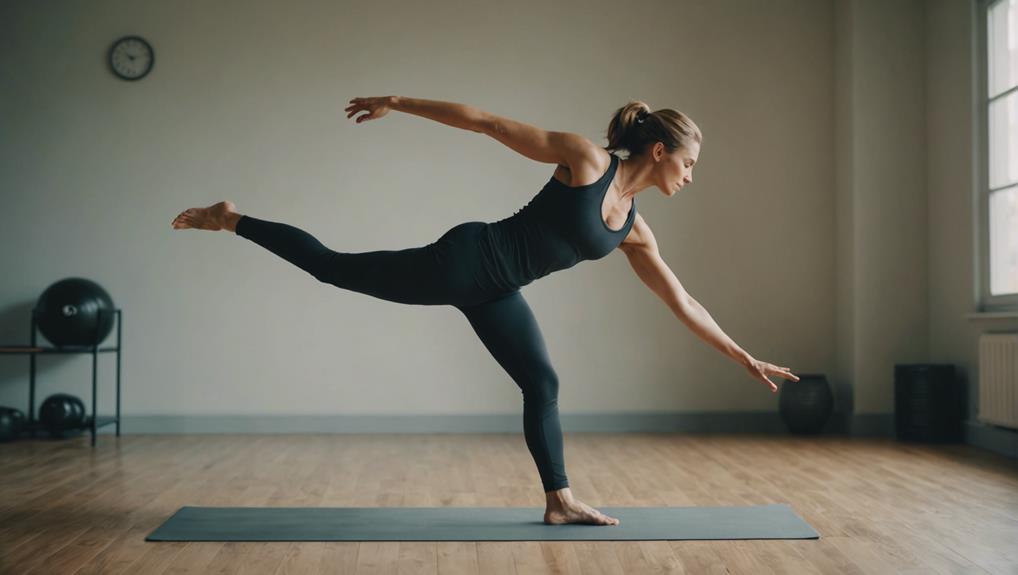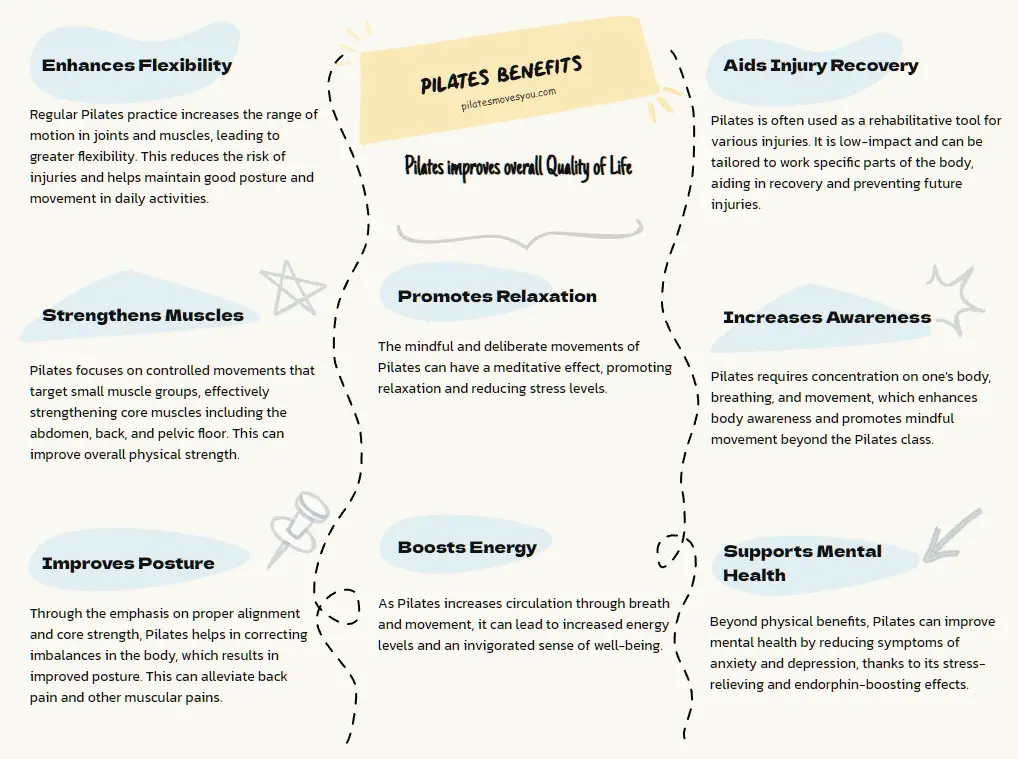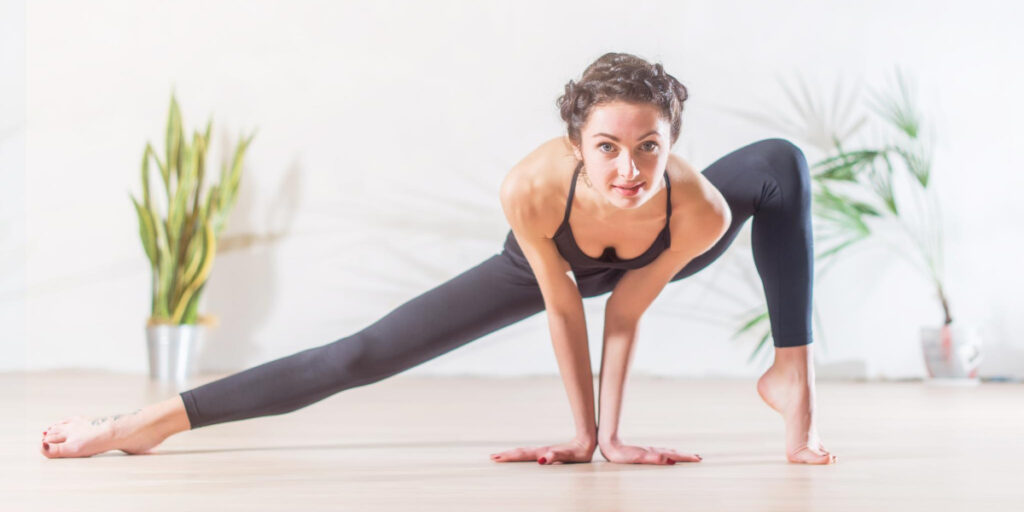You may be surprised to discover the vast array of scientifically proven benefits that Pilates has to offer.
From enhancing physical strength and flexibility to improving cognitive function and emotional well-being, Pilates has been shown to have a positive impact on various aspects of health.
Its effectiveness as a rehabilitation tool and its ability to enhance overall quality of life make it a compelling choice for individuals seeking holistic well-being.
The evidence supporting the benefits of Pilates goes beyond the physical domain, hinting at a deeper connection between mind and body that you won’t want to miss exploring further.
Key Takeaways
- Pilates enhances coordination, agility, strength, and flexibility.
- Improves stability, posture, proprioception, and control over movements.
- Enhances mental acuity, cognitive function, and emotional well-being.
- Benefits specific groups like those with multiple sclerosis and women’s health.
- Overall quality of life improvement through physical health, psychological well-being, and social interaction.
Improve fitness & balance

Improving fitness and balance through Pilates can have significant positive impacts on various aspects of physical well-being for individuals with Parkinson’s disease.
Pilates enhances coordination, agility, strength, and flexibility, contributing to increased stability, improved posture, enhanced proprioception, and better control over movements.
By engaging in Pilates, individuals with Parkinson’s disease can experience improved mobility and endurance, essential for daily activities and overall quality of life.
The focus on core strength and controlled movements in Pilates helps individuals with Parkinson’s disease build a strong foundation for movement, leading to enhanced balance and coordination.
This improved physical fitness not only aids in better postural alignment and stability but also supports the development of proprioceptive awareness and motor control.
With Pilates, individuals with Parkinson’s disease can work towards better functional autonomy and a higher level of physical well-being, ultimately enhancing their overall quality of life.
Pilates appears to positively affect neuromotor fitness
Pilates positively impacts neuromotor fitness, particularly focusing on enhancing balance and coordination, as evidenced in studies involving older adults.
This form of exercise appears to have specific benefits related to cognitive function, motor control, postural stability, movement coordination, and the aging process.
The table below highlights the key aspects of how Pilates affects neuromotor fitness in older adults:
| Aspect | Impact | Evidence |
|---|---|---|
| Cognitive function | Improved focus and mental acuity | Studies show positive effects |
| Motor control | Enhanced precision and movement quality | Pilates enhances motor control |
| Postural stability | Increased balance and core strength | Pilates improves postural stability |
| Movement coordination | Better coordination and body awareness | Pilates enhances movement coordination |
Pilates can benefit people with multiple sclerosis
Can Pilates be a supportive exercise for individuals with multiple sclerosis?
Pilates has shown promise in benefiting people with multiple sclerosis by improving cognitive function, motor skills, pain management, and quality of life. Studies suggest that Pilates can help enhance cognitive function in individuals with multiple sclerosis.
Additionally, engaging in Pilates exercises may aid in managing pain associated with the disease and contribute to better quality of life for those living with multiple sclerosis.
Moreover, Pilates has been linked to improvements in motor skills, which can be particularly beneficial for individuals with multiple sclerosis to maintain or enhance their physical abilities.
While Pilates may not alter the disease progression itself, it can offer valuable support in managing symptoms and improving overall well-being for individuals with multiple sclerosis.
Pilates may offer benefits for women’s health
Considering the limited evidence available on its effectiveness for various health conditions, Pilates may hold promise for enhancing women’s health outcomes, particularly in reducing pain and improving quality of life.
When it comes to women’s health, Pilates shows potential benefits across different areas, as summarized in the table below:
| Benefits | Effects |
|---|---|
| Pregnancy benefits | Limited evidence available |
| Breast cancer effects | Limited evidence available |
| Obesity management | Limited evidence available |
| Low back pain relief | Limited evidence available |
| Research gaps | More high-quality trials needed |
Despite the emerging evidence indicating positive effects on quality of life and lower extremity endurance, there remains a significant gap in research concerning the benefits of Pilates for women’s health.
More high-quality randomized controlled trials are essential to fully understand the potential advantages Pilates may offer in improving women’s health outcomes in various conditions.
Pilates is an effective rehabilitation tool
Rehabilitation through effective Pilates exercises has shown significant benefits for adults over 50 with chronic musculoskeletal conditions, improving pain, physical function, and overall quality of life. Pilates serves as a valuable tool in rehabilitation, leading to positive rehabilitation outcomes and clinical effectiveness.
It aids in functional improvement, offering effective pain management strategies for conditions like back pain, neck pain, knee osteoarthritis, and osteoporosis. The long-term benefits of Pilates in reducing pain and disability have been well-documented, with studies showcasing its efficacy comparable to other forms of exercise.
Additionally, group Pilates exercises have demonstrated good adherence rates among this demographic. By incorporating Pilates into rehabilitation programs, individuals can experience improved physical function, reduced pain, and enhanced quality of life. The evidence supports Pilates as a safe and effective method for enhancing the overall well-being of older adults with chronic musculoskeletal issues.
Pilates improves Quality of Life
Pilates’ impact on quality of life is significant, particularly for individuals dealing with chronic musculoskeletal conditions.
Engaging in Pilates not only improves physical health but also enhances psychological well-being, social interaction, and overall quality of relationships.
The long-term effects of Pilates extend beyond the physical domain, contributing positively to mental health and emotional stability.
Adherence factors, such as the enjoyment and psychosocial benefits reported by participants, play a vital role in sustaining a Pilates practice and reaping its full benefits.
Group Pilates exercises, in particular, offer a sense of community and support, further enhancing the quality of life for individuals.
The table below summarizes the key aspects of how Pilates influences quality of life:
| Quality of Life Benefits from Pilates |
|---|
| Psychological well-being |
| Social interaction |
| Long-term effects |
| Adherence factors |
| Quality of relationships |
Pilates improves physical and mental wellbeing
Improving both physical and mental well-being, Pilates offers significant benefits through once-a-week exercises. Pilates enhances the mind-body connection, promoting a deeper understanding of how your body moves and functions. This increased awareness can help you improve your overall physical performance and prevent injuries. Additionally, Pilates is effective in reducing stress levels, allowing you to unwind and relax both mentally and physically.

Moreover, Pilates strengthens core muscles, which are essential for stability and proper posture. By targeting these muscles, Pilates not only improves your physical strength but also enhances your balance and coordination. Additionally, Pilates helps in enhancing flexibility, allowing you to move more freely and with greater ease.
In terms of emotional well-being, Pilates has been shown to have a positive impact on your mood and mental state. Engaging in Pilates exercises once a week can help boost your emotional well-being, increase your self-awareness, and contribute to an overall sense of mental wellness.
Pilates benefits self-management of musculoskeletal conditions
Enhancing your ability to manage musculoskeletal conditions independently, Pilates offers a proactive approach to self-care and pain management. Through targeted exercises and a focus on functional movement, Pilates can have a substantial impact on your overall well-being. Here are three key benefits of Pilates for self-management of musculoskeletal conditions:
- Pain Management: Pilates is effective in reducing pain associated with musculoskeletal conditions by improving muscle flexibility and strength, which can alleviate discomfort and enhance mobility.
- Functional Movement: By emphasizing proper alignment and movement patterns, Pilates helps you perform daily activities with greater ease and efficiency, reducing strain on your muscles and joints.
- Muscle Strength: Pilates targets all major muscle groups, enhancing strength and stability, which is vital for supporting and protecting your joints, ultimately aiding in injury prevention.
Incorporating Pilates into your routine not only assists in managing existing conditions but also promotes exercise adherence, leading to long-term benefits for your musculoskeletal health.
Pilates offers many benefits to dancers

Regularly incorporating Pilates into your dance regimen can greatly enhance your strength, flexibility, and balance. As a dancer, these benefits are essential for improving your performance and preventing injuries. Here’s how Pilates specifically benefits dancers:
| Benefits | Description |
|---|---|
| Dancer Performance | Enhances overall performance through improved strength, flexibility, and balance. |
| Core Strength | Strengthens core muscles, essential for stability and control in dance movements. |
| Flexibility Enhancement | Increases flexibility, allowing for a greater range of motion and fluidity in dance routines. |
| Body Awareness | Enhances body awareness, helping dancers understand and control their movements better. |
| Alignment Improvement | Improves posture and alignment, vital for executing dance techniques correctly. |
Incorporating Pilates into your training routine can lead to significant improvements in your dance skills, helping you reach your full potential as a performer.
Frequently Asked Questions
What Science Says About Pilates?
Pilates research shows it boosts muscle strength, flexibility, and posture correction. It enhances core stability and reduces stress. You’ll benefit from its proven advantages in these areas, making it a valuable addition to your routine.
Does Pilates Really Change Your Body?
Pilates can indeed change your body by toning muscles, improving flexibility, correcting posture, enhancing core strength, and reshaping your body. Consistent practice offers holistic benefits that can transform how you look and feel.
What Do Doctors Say About Pilates?
Doctors highlight Pilates for its medical benefits, expert opinions endorse it for rehabilitation support and physical therapy, recognizing its effectiveness in improving posture. Embrace Pilates for a healthier you, backed by medical professionals and research.
What Is Pilates Most Effective For?
Pilates is most effective for improving core strength, flexibility, posture, and injury prevention, enhancing your mind-body connection. It helps you build a strong core, increase flexibility, correct posture, prevent injuries, and connect your body and mind.
Final Thoughts
To sum up, Pilates has been scientifically proven to offer a wide range of physical, mental, and emotional benefits.
From improving fitness and balance to enhancing quality of life, Pilates is an effective tool for rehabilitation, self-management of conditions, and overall well-being.
Whether you’re looking to strengthen your core, improve your posture, or simply feel better both physically and mentally, incorporating Pilates into your routine can have a positive impact on your overall health and wellness.
Sources
https://consensus.app/papers/effects-pilates-fitness-older-adults-review-cancela/f9f8652361a45e3aa1e86757ff1983a8/
https://consensus.app/papers/pilates-people-sclerosis-review-metaanalysis-sanchezlastra/d37d2d07fd0e55089c122b325de9b170/
https://consensus.app/papers/pilates-method-womens-health-systematic-review-mazzarino/a7bbd321a2985f63ae5ee9919a55f53e/
https://consensus.app/papers/pilates-rehabilitation-tool-review-byrnes/0915966522d95795a2445ef7bf0d594b/
https://consensus.app/papers/review-effectiveness-pilates-pain-disability-function-denhamjones/2b298b30588a5f7caa84533cf7591447/
https://consensus.app/papers/effects-pilates-method-patients-multiple-sclerosis-rodr%C3%ADguezfuentes/a223d77f0fd950dd942468773ae80615/
https://consensus.app/papers/benefits-onceaweek-pilates-exercises-women-10week-study-tolnai/ff38e70e744d5fc5a7a626dc2a678c44/
https://consensus.app/papers/perceived-benefits-preferences-exercises-within-pilates-gaskell/c0a158dd4e5b5c40804df5d442673c7e/
https://consensus.app/papers/pilates-method-ballet-technique-applications-dance-ahearn/504662f88c815e4588960fec8ba2a6c0/




